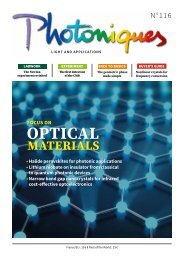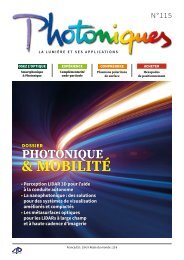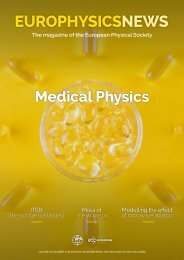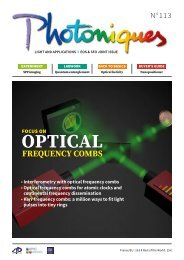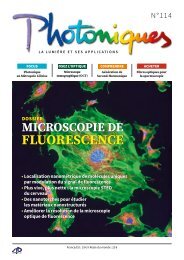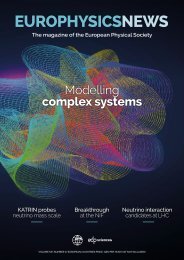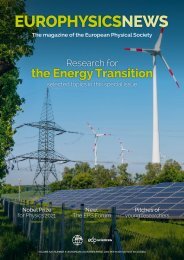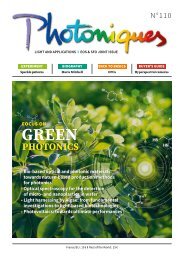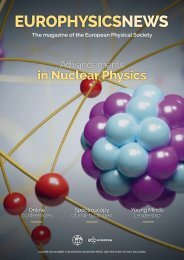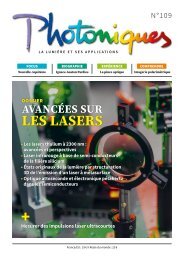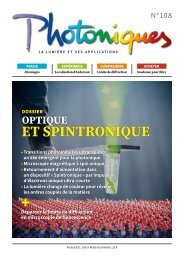Europhysics News 53-4
Europhysics News Quantum Issue
Europhysics News Quantum Issue
Create successful ePaper yourself
Turn your PDF publications into a flip-book with our unique Google optimized e-Paper software.
FEATURES<br />
WHEN A MOLECULAR MOTOR<br />
DOES THE QUANTUM LEAP<br />
l 1,2 Oliver Gröning 1 , Samuel Stolz 1,2 , Jan Prinz 1,2 , Harrald Brune 2 , Roland Widmer 1<br />
l DOI: https://doi.org/10.1051/epn/2022405<br />
l 1 Empa, Swiss Federal Laboratories for Materials Science and Technology, 8600 Dübendorf (Switzerland)<br />
l 2 Institute of Physics, École Polytechnique Fédérale de Lausanne, 1015 Lausanne (Switzerland)<br />
In his seminal 1959 lecture “There’s Plenty of Room at the Bottom” Richard Feynman<br />
has put forward two challenges [1] .The first was to shrink letters to a size, which allowed<br />
writing the whole Encyclopedia Britannica on the head of a pin - which was achieved in<br />
1985 [2].The second challenge read: "It is my intention to offer a prize of $1,000 to the<br />
first guy who makes a rotating electric motor which can be controlled from the outside and,<br />
not counting the lead-in wires, is only 1/64 th inch cubed" [1].<br />
. FIG. 1: Illustrative<br />
comparison of a<br />
classical (left) and a<br />
quantum tunneling<br />
(right) transition<br />
from one minimum<br />
of a potential<br />
energy landscape<br />
to another.<br />
Less than a year later, William McLellan met<br />
this challenge by scaling down an electric<br />
motor consisting of just 13 parts and weighing<br />
some 250 μg to the required size [3].<br />
Motivated by the ubiquity of nanoscale machines<br />
in biology, the desire to achieve ever smaller sizes remained<br />
vivid and the first motors brought to molecular<br />
dimensions were reported in 1999 [4,5]. To this day,<br />
most synthetic molecular machines, although driven<br />
by quantum processes such as light absorption and<br />
bond reconfiguration [6], exhibit classical kinetics.<br />
This contrasts with quantum mechanical real space<br />
tunneling. As illustrated in Fig. 1, instead of a quasi-continuous<br />
classical trajectory, the process of a particle<br />
overcoming a potential barrier by tunneling looks<br />
more like an abrupt leap. In a quantum system, having<br />
determined a particle's position at time t 0 by measurement,<br />
its wave function will subsequently spread out<br />
over time, such that it acquires a nonzero probability<br />
to be in places, where it would be classically forbidden.<br />
When the position of the particle is measured at a later<br />
time t1 and its wave function collapses with non-zero<br />
probability in the adjacent well, it might thus seem to<br />
have “tunneled” through the potential barrier.<br />
For quantum mechanical tunneling to occur with<br />
non-vanishing rates the requirements are that the energy<br />
barrier between the initial and final configuration<br />
is small, the tunneling distance short, the mass of the<br />
system in motion light, and the operation temperature<br />
low. To give an idea of the scales: on a copper surface<br />
a hydrogen atom with mass m H = 1.67e-27 kg tunnels<br />
a distance of 2.55 Å (= 2.55e-10 m) across a potential<br />
barrier of about 0.2 eV (= 3.2e-20 J) with an average<br />
rate of about once every 40 minutes [9]. Scaling<br />
down a unidirectional molecular motor to meet the<br />
requirements for real space tunneling is therefore a<br />
formidable challenge.<br />
Like an ordinary electric motor, our atomic motor<br />
consists of a stator and a rotor. As we want to achieve a<br />
directional motion, either the stator or the rotor should<br />
show a handedness or chirality, which makes a clockwise<br />
(CW) rotation inequivalent to a counter-clockwise<br />
(CCW) turn. An atomic cluster of the surface of<br />
a chiral Palladium-Gallium (PdGa) crystal realizes our<br />
chiral stator [7,8]. Figure 2a shows its pinwheel-like<br />
atomic structure, which consists of 3 central Palladium<br />
atoms (light blue), which are surrounded by deeper<br />
layers of 6 allium (red) and 3 Palladium atoms (dark<br />
blue). Having a chiral stator allows us to use very small<br />
and symmetric rotors such as a single rod-shaped acetylene<br />
(C 2 H 2 ) molecule with a length of about 3.3 Å and<br />
24 EPN <strong>53</strong>/4



